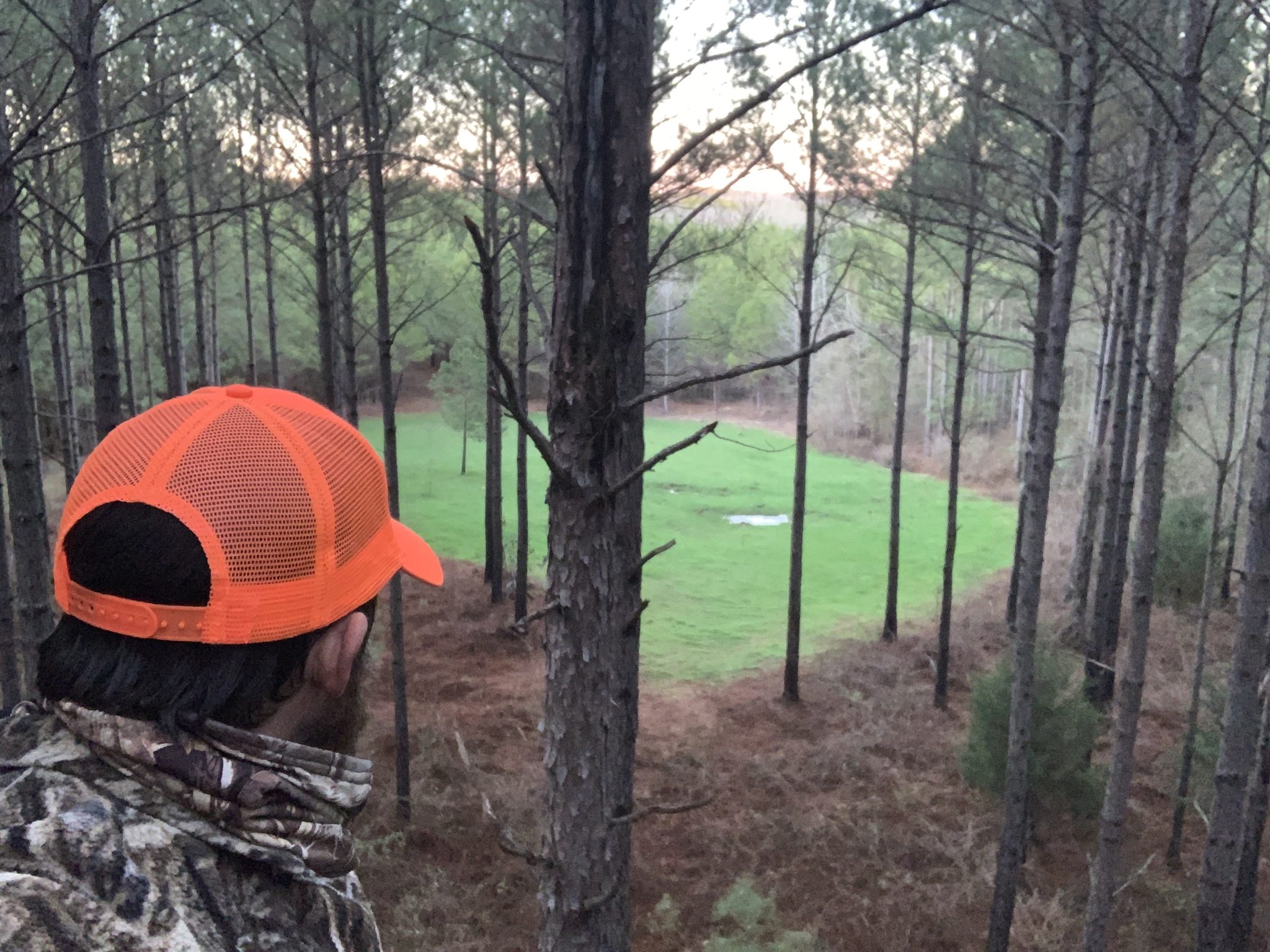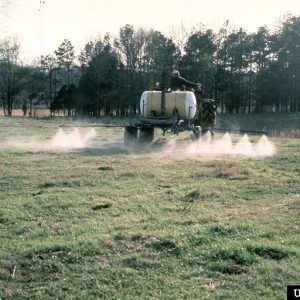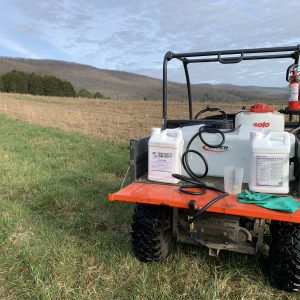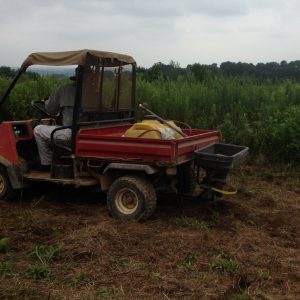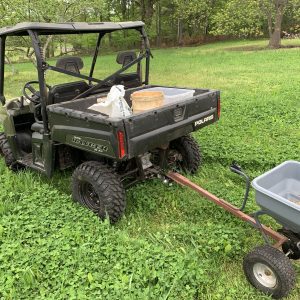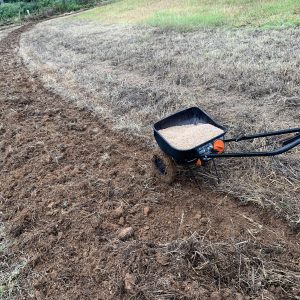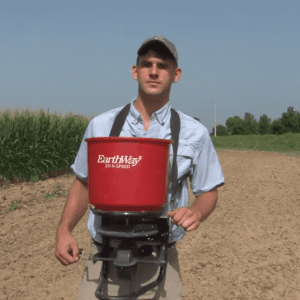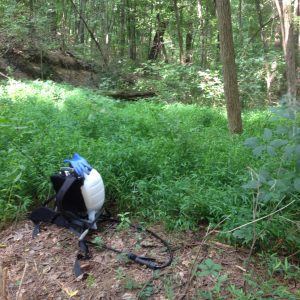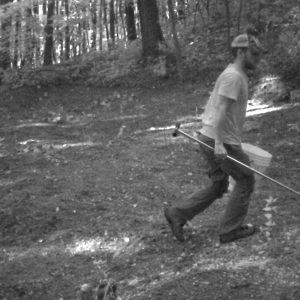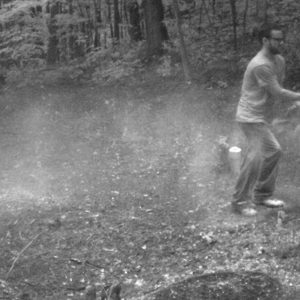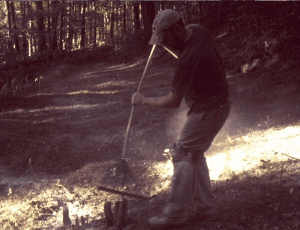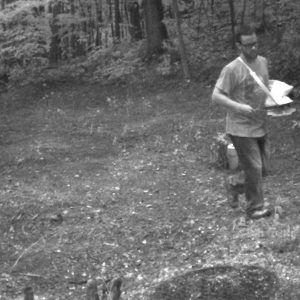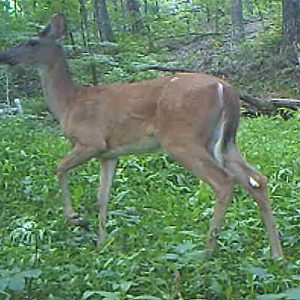Forestry & Wildlife

Planting cool-season food plots for white-tailed deer (Odocoileus virginianus) and other wildlife not only provides hunting opportunities but also provides food for wildlife during times of nutritional stress.
Planting cool-season food plots (CSFP) for whitetail deer (Odocoileus virginianus) and other wildlife improves hunting opportunities and provides food for wildlife during times of nutritional stress. While both cool- and warm-season food plots are valuable tools for wildlife managers, they do not replace comprehensive wildlife and vegetation management plans. Managing native vegetation to create cover and forage can outproduce food-plot production at three to four times more biomass per acre and at a fraction of the cost. It is important to understand that food plots are not habitat (as they often lack water, cover, and space) and they do not grow big bucks or gobblers—they are instead a supplement to natural foods. Still, because deer can be limited by nutrition, plots often serve an important role in deer management and hunter success. While the focus of this publication is deer, much of the information is also relevant for attracting and supplementing nutrition for other wildlife such as wild turkeys (Meleagris gallopavo) cottontail rabbits (Sylvilagus floridanus) various songbirds, and even pollinators.
Planting for deer provides several benefits to both wildlife and hunters. CSFPs produce green browse from fall to early spring when green vegetation is sparse or unavailable. This provides carbohydrates and protein in an otherwise stressful time and helps deer maintain or rebuild their energy and body condition, especially bucks re-bounding after the stresses of the rut. Warm-season plots (discussed in another publication) provide green browse and high nutrient vegetation (and sometimes, cover) in late summer and early fall, another time of nutritional stress. In addition, these plantings often provide seed and grain that deer and birds feed on. The reliable food source that plots create can increase wildlife sightings and hunter success by attracting a multitude of game animals to frequent or even hold to a property.
Location

Figure 1. Online aerial imagery and mapping software is an excellent tool for planning food plots and land-management activities.
Online mapping tools are invaluable when planning land-management activities such as food plots. Two such tools that are free and easily accessible are the United States Department of Agriculture (USDA) Natural Resources Conservation Service (NRCS) Web Soil Survey and the United States Fish and Wildlife Service (USFWS) Wetlands Mapper. Figure 1 shows how using aerial imagery, terrain overlays, and measuring tools can help you better plan land-management activities, choose the best locations, know the exact acreage of plots, and gain insight into surrounding land use.
It is best to locate food plots in areas that are accessible for your equipment and already open, such as logging decks, woods roads, power lines, storm or bark beetle, damaged areas, old fields, and fire breaks. Locations with easy access, relatively flat terrain, and productive, moderate to well-drained soils are desirable. Some locations, such as poorly drained areas and those near property lines or in view of public roads, should be avoided. Food plots that are seldom disturbed and placed near bedding cover are typically used more by deer, especially during daylight hours.
Another important consideration is hunting access and how the plot may be hunted on a given wind direction. It is best to locate food plots and stand locations so that they may be accessed and hunted in multiple wind directions without alerting game.
Plot Size and Shape
CSFPs typically range in size from a 1⁄4 acre to 5 acres. Small plots can be overbrowsed in areas with moderate to high deer density. Larger plots provide more food but cost more and can present longer shots when hunting. Rectangular, square, or round shapes are best. Irregularly shaped plots make planting difficult, disrupt a hunter’s view, and cast shade on the plantings, which reduces production. In addition, leaving trees and shrubs throughout a plot shade out plantings, use water and nutrients, reduce shot opportunities, and create obstacles for equipment. If shorter shot distances are desired, such as with bowhunting or hunting with youth, create pinch points by designing a plot that necks down in the middle, similar in shape to an hourglass.
Generally, a well-balanced property will have 1 to 5 percent planted in food plots that are spaced evenly across the property. However, this can vary greatly based on factors such as your personal objectives, the composition of the property (closed canopy forest, open land, young forest), and neighboring land-management activities. Essentially, the more forested or less productive and shaded the property or surrounding lands are the more food plots are required to provide nutrition and reduce overbrowsed plots.
Soil Amendments
The most productive food plots are first dictated by soil quality. Collecting a soil sample to determine the soil pH and nutrient concentrations, accurately interpreting the test results, and following through with the amendment recommendations are integral parts of increasing the yield and palatability of a crop. Soil test boxes and laboratory forms can be found at any county Extension office, free of charge.
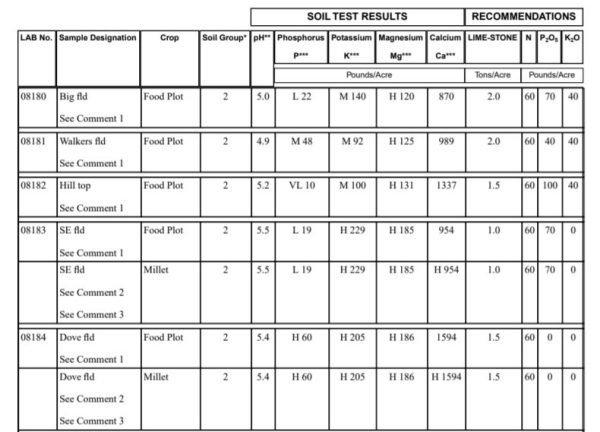
Figure 2. Sample soil test report from the Auburn University Soil Testing Laboratory.
Lime recommendations are based on pH and given in tons per acre. Generally, a soil pH of less than 6.0 reduces nutrient availability in the soil and uptake for many plants. Applying the recommended amount of agricultural or dolomitic limestone raises the pH and makes nutrients more available, but it can take 6 months or longer to take full effect. Applying lime at planting, however, is better than no lime at all, and disking in lime can reduce the reaction time.
Fertilizer recommendations are given in pounds per acre and are based on the amount of nitrogen (N), phosphorous (P), and potassium (K) in the soil and the crop to be planted (figure 2). Applying the correct amount of fertilizer requires calculating the amount needed to reach the recommended per-acre rate. Refer to the Alabama Extension Chemical Fertilizer Calculator if you need help with these calculations. More information about testing and amending soils can be found in Extension publication FOR-2080, “Soil Testing, Liming, and Fertilizing Wildlife Food Plots.”
Results in figure 2 show nutrient needs and recommendations based on soil samples taken from five food-plot locations and the crops to be planted. Although these samples were taken from the same property, the plots have different recommendations because of varying soil conditions.
Site Preparation
In Alabama, it is best to prepare plot sites and control vegetation during the months of August and September so that the plots can be ready to plant in September or October. Mow the plots, and allow them to grow back to a height of 5 to 10 inches to help reduce thatch and allow herbicides to better contact actively growing vegetation. Apply herbicide to kill all existing vegetation before planting. Herbicide recommendations vary based on the weed species in the plot, but a foliar application of 1.5 to 2 quarts per acre of a 41 percent glyphosate product is commonly used to kill existing vegetation before conventional tilling or no-till planting. For some difficult-to-control broadleaves, 2,4-D is commonly added to the tank mix. If the herbicide does not contain a surfactant, include an additive that helps increase contact and uptake.
Figure 3 shows some equipment that can be used to spray herbicide (tractor with tank and boom, ATV spray tank and boomless nozzle, 4-gallon backpack sprayer). Always spray plots at least 2 weeks before tilling so there is time to respray spots that were missed. Be aware of preplant application timing as some products and rates require 1 to 4 weeks between spraying and planting. Also, fields will till better when vegetation and roots are dead, particularly when using smaller equipment and implements. Remove any trees and shrubs and treat the stumps of undesirable resprouters using a cut-stump application of one part water to one part 41 percent glyphosate solution.
- Photo credit: John D. Byrd, Mississippi State University, Bugwood.org
- Figure 3. A tractor and boom sprayer is ideal for large food plots, but since most food plots are small in acreage, they can often be effectively sprayed with a 25-gallon ATV sprayer or even a 4-gallon backpack sprayer.
Planting
Just before seeding, till the food plot, using a disc to further reduce weeds and create a seed bed for good seed-to-soil contact. The most common method of seeding food plots is broadcasting using an electric or ground-driven spreader, hand seeder, or simple garden seeder (figure 4).
- Figure 4. Both seed and fertilizer can be broadcast using a garden spreader or one mounted to or pulled by an ATV. A hand-operated spreader is used to broadcast seed only.
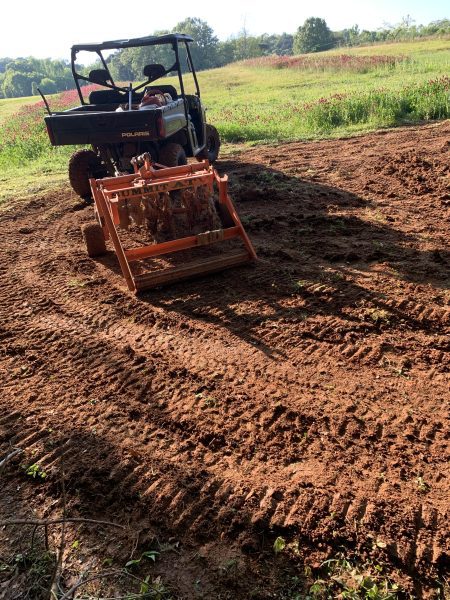
Figure 5. After seed is broadcast, tow a cultipacker over a plot to press the seed into the soil and create a firm seed bed.
It is best to first broadcast large- to moderate-sized seeds, such as peas and cereal grains, and lightly disc or drag the plot to cover seed at a depth of 0.5 to 1 inch. Next, broadcast smaller seeds, such as clover and chicory, and press them into the soil using a cultipacker (figure 5). If a cultipacker is not available, lightly drag the field using a section of chain-link fence, or repeatedly drive over the plot using a small tractor or ATV to produce similar results.
No-till drills are another option for planting wildlife food plots. No-till drilling requires less seed, helps retain soil moisture, reduces erosion, and helps reduce hardpan, which is compacted soil 8 to 15 inches deep that inhibits deep root systems, can lack moisture, and increase ponding. The downside of this planting method is that no-till drills are more expensive to own and maintain than a conventional disc and spreader. However, they may be available for loan through county USDA programs and for rent by private equipment rental companies.
You do not have to have high-end farming equipment to plant effective food plots, however. Small plots prepped and planted using an ATV or even by hand can be productive (and sometimes the only option) for more remote or difficult-to-access areas such as those with limited roads, rough terrain, or swamps.
A backpack sprayer, rake, and hand seeder can greatly improve an otherwise idle or unplanted site (figure 6). If sunlight is limited, clear trees and brush using a chainsaw, handsaw, and loppers. Site-prepping an area using a backpack herbicide application, followed by a small prescribed burn, can create a great no-till seed bed to be top sewn using a hand spreader as the ash will cover the seed and hold moisture. Even if you are unable to burn, the site can be raked. Seeding into sparse, dead vegetation can provide cover and retain moisture for new plantings. It is best to choose small- seed varieties for these plots as it is difficult to create a good seed bed and cover larger seeds by hand, or you may plan to plant larger seeds at a higher rate to account for loss by birds and poor soil contact. Although they offer little impact on wildlife health and nutrition, plots such as these can still attract wildlife for hunting purposes. They often cost little more than a few dollars and a bit of sweat equity, but they can yield results for the budget-oriented or remote hunter.
- Figure 6. This series of images demonstrates the process of planting a small 1/8-acre remote plot only accessible by foot. A backpack sprayer of glyphosate was used to kill existing vegetation. A soil test was taken, and bagged lime was applied by hand and raked in. Seed was distributed using a hand-spreader. White ladino clover and chicory were selected for the moist, shaded site and because small-seeded varieties are well-suited for no-till planting. This plot, though small, was productive and frequently visited by deer.
When to Plant
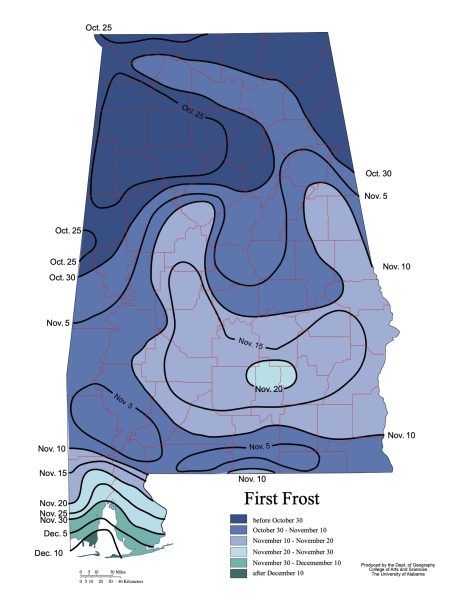
Figure 7. First frost is a major consideration when planting crops. Ideally, it is best if most cool-season crops are planted at least 45 days ahead of first frost so they have time to establish and provide maximum forage value. The timing of first frost in Alabama can vary widely throughout state.
Table 1 shows planting dates for commonly planted CSFPs. Most cool-season food plots in Alabama are planted in September and October, but air temperature and soil moisture should be considered. Crops that do not receive adequate rainfall will have poor germination. Those that are planted late may have slow growth rates and can become stunted by frost. If possible, plant when there is moisture in the soil (but not so much that the soil sticks together and clumps), rain is in the near forecast, and frosts are a month or more away (figure 7).
Table 1. Planting Information for Select Cool-Season Crops when Planting as a Single Species*
* If creating mixes, rates will be lower.
| Crop | Broadcast Seeding Rate (PLS/acre) | Planting Date | Site Suitability | Inoculant Group |
|---|---|---|---|---|
| Austrian winter pea (annual) | 40 lbs. | Sept. 1 - Nov. 1 | Widely adapted | C |
| Cereal rye (annual) | 120 lbs. | Aug. 15 - Nov. 1 | Well drained, sandy to clay loams | - |
| Chicory (perennial) | 5 lbs. | Aug. 15 - Oct. 15 | Moderately well drained | - |
| Clover - Alsike (perennial) | 10 lbs. | Sept.1 - Nov. 1 | Tolerates poorly drained soils | B |
| Clover - Arrowleaf (annual) | 10 lbs. | Sept.1 - Nov. 1 | Mod. fertile, well drained | O |
| Clover - Ball (annual) | 5 lbs. | Sept. 1 - Oct. 30 | Tolerates poorly drained soils | B |
| Clover - Berseem (annual) | 25 lbs. | Sept.1 - Nov. 15 | Fertile, well drained | R |
| Clover - Crimson (annual) | 30 lbs. | Sept. 1 - Nov. 1 | Well drained | R |
| Clover - Red (annual) | 15 lbs. | Sept. 1 - Nov. 15 | Fertile, well drained | B |
| Clover Subterranean (annual) | 10 lbs. | Sept. 1 - Oct. 15 | Tolerates moist sites | WR |
| Clover - White Ladino, Durana, Patriot, Osceola, etc. (perennial) | 4 lbs. | Sept. 1 - Nov. 15 | Widely adapted, tolerates moist soils and shade | B |
| Oats (annual) | 120 lbs. | Aug. 15 - Oct. 30 | Clay and sandy loams | - |
| Radish (biennial) | 12 lbs. | Aug. 15 - Oct. 1 | Widely adapted, but not wet soils | - |
| Rape and Kale (annual) | 10 lbs. | Sept. 1 - Oct. 15 | Well drained, fertile | - |
| Sugar beet (biennial) | 8 lbs. | Aug. 15 - Sept. 30 | Fertile, well drained loams | - |
| Triticale (annual) | 120 lbs. | Aug. 15 - Oct.15 | Well drained, sandy loam to clay | - |
| Turnip (biennial) | 10 lbs. | Sept. 1 - Oct. 15 | Fertile, well drained | - |
| Winter wheat (annual) | 120 lbs. | Aug. 15 - Nov. 1 | Moderate to heavy soils, not poorly drained | - |
What to Plant
Deer forage preferences can vary by location and season. The availability and variety of natural and planted foods deer encounter in their home range dictate feeding habits. As the abundance and quality of foods change, so do deer feeding preferences; therefore, a variety of plantings is generally better than a single crop. Cereal grains including oats, triticale, cereal rye, and awnless wheat (figure 8), legumes and forbs such as Austrian winter peas, chicory, and the clovers (figure 9), and brassicas such as rape, turnips, and radish (figure 10) are common examples of cool-season forages planted for deer.
- Figure 8. Compare awned wheat (left) and awnless wheat (right). The awns, stiff hairlike structures on the seed head, deter grazing. Awnless wheat varieties (USG 3013, Winfield 9203, Becks 88, Dyna-Gro 9223, Winfield SRW 9434 and many others) are preferred over awned or “bearded” wheat because deer, turkey, and other wildlife more readily feed on the seed produced.
- Figure 9. The Annual Deer and Turkey Mix provides forage from October through June. Inoculated crimson clover and arrowleaf clover (blooming) are adding nitrogen to the soil, which also benefitted the oats that have seeded out in the background.
- Figure 10. The browse that green, leafy tops of brassicas provide (such as this Daikon radish) can be a draw to deer in the winter months as can the starchy tubers that also reduce soil compaction.
It is important to note that legumes (clovers, peas, vetch, and beans) can fix nitrogen from the atmosphere if the proper bacteria are in the soil. To ensure the bacteria is present, purchase coated seed or add the bacteria, or inoculum, to the seed before planting. Keep in mind that seed coating can make up for 50 percent of the seed weight, so be sure to adjust seeding rates accordingly.
If you choose to add the inoculum, purchase that specific to the legume you are planting (table 1). It can be purchased in bags with enough inoculant to treat 50 to 100 pounds of seed. Because the bacteria have a limited shelf life, check the date on the product and buy only what is needed for the current planting season.
To inoculate your seed, measure the proper amount of inoculant for the pounds of seed you are planting, add four parts of cool, nonchlorinated water to one part sugar, and mix it into the seed by hand or using a small cement mixer until the seed is evenly coated and not clumped. Spread it and allow it to dry in the shade for a few hours, and then it is ready for planting.
Table 2. Herbicides Commonly Used in Cool-Season Food Plots* **
** Always read the herbicide label and follow directions before applying herbicide.
| Active Ingredient | Trade Names* | Applications |
|---|---|---|
| 2,4-D | 2,4-D Amine, Barrage, Formula 40, Opt-Amine, Weedar 64, many brands | Controls many broadleaf weeds (including crops such as clover, chicory, and winter peas). Can be combined with glyphosate as a site prep, burn down mix for more difficult to control broadleaves. |
| 2,4-DB | 2,4-DB 175, 2,4-DB 200, Butoxone, Butyrac 200 | Controls select broadleaf weeds in grains and some forage legumes like clover. Does not kill as many broadleaf species as 2,4-D and can be used on many clover varieties. |
| Clethodim | Arrow, Clethodim 2 EC, Envoy, Select Max, Selection, Tapout | Controls many grassy weeds (including wheat, oats, and other grains). For use in broadleaves such as winter peas and clovers. |
| Glyphosate | Accord, Cornerstone Plus, Eraser, Glyphosate 4+, Roundup, many brands | Broad spectrum herbicide, frequently used in site preparation for burn-down prior to disking & planting. |
| Imazapic | Panoramic 2SL, Plateau | Controls many problematic grasses, sedge, and broadleaf species. Postemergent and preemergent activity as it is soil active |
| Imazethapyr | New Path, Pursuit, Thunder | Controls various grassy and broadleaf weeds in clovers, peas, and other broadleaves. Will kill wheat, oats, and other grains. Preplant, premergent, and postemergent activity as it is soil active |
| Pendimethalin | Prowl, Stealth | Controls many grasses and forbs in legumes and winter peas. Preplant, and preemergent herbicide. |
| Sethoxydim | Poast, Poast Plus, Segment, Vantage | Controls many grassy weeds (including wheat, oats, and other grains) in broadleaves such as clovers and winter peas. |
Recommended Mixes
The crops listed in this publication stay green throughout the winter, are attractive to deer and other wildlife, and can provide forage from fall through summer. These forages may be planted as a mix or as a single-species food plot. It is easier to manage weeds in plots that do not have a mix of broadleaves and grains because it allows for many more herbicide options (table 2).
When planting single species, it is best to provide multiple plots with different forages across the property. Table 1 lists planting rates and dates for common cool- season varieties. Some forages produce early, while others produce later in the growing season (figure 11). It is also important to know that some clovers can produce for 3 to 5 years with proper maintenance including weed control (mowing and spraying) and fertilizing. It is worth noting that you should avoid perennial ryegrass when planting for wildlife. Although deer do eat it, it is usually because they have little else to choose from. It is a low- preference, low-quality forage that is incredibly difficult to eradicate because it is a heavy reseeder and some varieties show herbicide resistance.
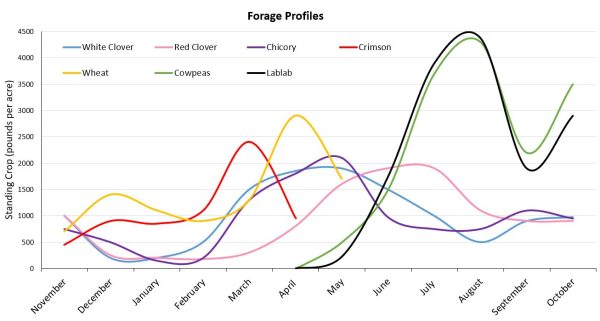
Figure 11. Various forages produce at different times of year. Wheat and oats are most productive in the winter and early spring, while clovers (depending on the variety) are productive in the fall through mid-summer. Planting multiple forages, both annual and perennial, will provide nutrition throughout much of the year. (adapted from Harper, Craig. A. Wildlife Food Plots and Early Successional Plants. NOSCO, 2019.).
Choosing cool-season plantings does not have to be complicated or overly expensive. The following plantings are relatively simple, economical, and proven to provide quality nutrition and hunting opportunities. All rates are given on a per-acre basis for broadcast planting in pure live seed (PLS) (figure 12). Using the seed label in figure 12, germination is 85 percent and the pure seed is 96 percent. To calculate PLS, multiply germination by pure seed. For example: Germination (0.85) × pure seed (0.96) = 0.816 (81.6 percent PLS)
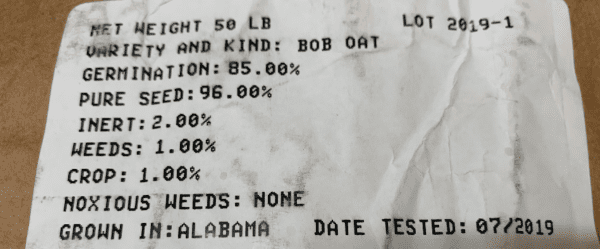
Figure 12. The rates in this publication (and many others) are for PLS. Certified and noncertified seed will have a tag on the bag that shows information about the contents. In particular, it shows the percentage of pure seed and germination. If the seed is a coated legume, the coating can make up a considerable amount of the weight in the bag.
To calculate the seed required for the desired planting rate, divide the desired rate by PLS. For example: Desired planting rate (120 pounds per acre) ÷ PLS (0.816) = 147 pounds
Easy Annual Hunting Plot Mix
120 lbs. Oats
or
120 lbs. Awnless wheat
or
60 lbs. Oats & 60 lbs. Awnless wheat
Cereal grains provide a simple, affordable, and effective plot that will attract deer by providing quick green-up and browse throughout the fall and winter. The grain resulting from awnless wheat will be eaten by deer and many other species, while oats will be fed on by birds and small mammals. Wheat can tolerate a wide variety of moisture levels, while oats are best on moderate- to well-drained sites but are not as cold tolerant. In addition, oats can be browsed for a longer window since wheat use declines if it is allowed to reach 12 inches in height (you may mow wheat to maintain palatability and use by deer).
The Annual Deer and Turkey Mix
40 lbs. Oats or Awnless wheat
15 lbs. Crimson clover
5 lbs. Arrowleaf clover
This simple mix provides forage for deer and turkey throughout the winter and early summer and is a great choice for dry, upland sites. The cereal grain provides a fast green-up, while the clovers are not far behind. Crimson matures first in the spring, as arrowleaf heads out in the early summer (figure 9). Again, grain is produced after oats or wheat mature, but the legumes continue to produce green browse into spring and good bugging areas for turkey poults as well. This plot can be mowed and sprayed in August after the arrowleaf dies out and overseeded with grains from September through October. Since both clovers are heavy reseeders, they will volunteer year after year as long as seed production was not limited from overgrazing.
Almost Season-Long Perennial Mix
25 lbs. Oats or Awnless wheat
5 lbs. White clover (Durana, Ladino, Osceola, Patriot)
7 lbs. Red clover
2 lbs. Chicory
This mix provides quality forage for most of the year, with low production only in August through September and January through February. It is very well suited to shaded and moist sites. If planting a drier site, you can shift rates to favor red clover (which tolerates drier sites and can produce into July) over white. Chicory performs well on many sites and is very drought tolerant. Cereal grains are only included in the initial planting for quick green-up as clover and chicory establish. This plot can persist for 3 to 5 years if properly managed by mowing, fertilizing, and spraying. The variety of green browse, long windows of production, and insect attraction makes this a great plot for deer, turkey, and many other species.
Wet-Site Clover Mix
40 lbs. Awnless wheat or Awnless triticale
4 lbs. White clover (Durana, Ladino, Osceola, Patriot)
5 lbs. Alsike clover
5 lbs. Berseem clover
Wet sites limit options for food-plot varieties, but this mix is a good choice for low areas and bottomlands. Berseem clover is an annual, producing from October through April, while the perennials white and alsike produce from May through July. Because berseem is a poor reseeder, it will likely require overseeding each fall. In overly wet sites or years of high rainfall, be prepared each year to overseed this entire mix in areas that were killed out.
Winter Greens Mix
5 lbs. Radish
3 lbs. Rape or Kale
1 lb. Turnip
All brassicas provide forage in the form of leafy, green tops, while the radish and turnip in this mix provide energy-rich tubers as well. An added benefit of radish is that their deep growing tubers can help to break up hardpan. Brassica plots generally excel as cold weather wears on, which may not always be the case in much of the southeast. Because of this, deer herds in some areas have been found to use brassica plots sparingly or at least require a few years of exposure or learning that brassicas and their tubers are edible. Therefore, it may be best to only dedicate small acreages to brassica plantings until your herd consistently uses them. Some managers dig up tubers to expose them to deer. Brassica are generally planted a month or so before most other cool-season varieties.
Commercial Mixes
There are many commercial food plot seed mixes on retail shelves but be sure to read the seed label. Many mixes provide good value, particularly for plots less than an acre, but some may not be suited to your goals or site and may come at a greater cost than mixing the seed yourself. Some commercial mixes contain very little of the advertised crop, instead consisting mostly of cheaper seed such as rye grass. Furthermore, you may find that cool- and warm-season varieties are in the same mix just so the customer sees something green come up, regardless of when or where they plant—a waste of seed and money and not a good value or wise practice. Also, some mixes create issues with seeding depth, for example, large-seeded Austrian winter peas mixed with small-seeded clovers. Lastly, some mixes could greatly limit your options for weed control or require that a variety in the mix be killed along with the weeds that are sprayed in the plot. Read labels and shop smart.
Alternate Plot Options
There are several other options for wildlife nutrition outside of planting a dedicated food plot. Perhaps the easiest is paying a farmer to leave select areas of corn or soybeans unharvested. Be sure to scout the areas you would like to purchase and make sure they are still holding corn or beans. Remember that shaded and moist areas are poor producers, and some areas may already be decimated by deer, and you do not want to pay for damaged, overbrowsed crops or empty stalks. Agree with the farmer on the location and total acreage, and expect to pay market value based on that field’s current bushel-per-acre production.
You could also choose to let last year’s wheat or warm- season corn plot fallow for a year or two, often termed “dirty plot.” The forbs and grasses that respond after planting are sometimes beneficial, but you must watch out because sometimes they are not. This option requires plant identification and some spot spraying, but the plants that respond can provide some great wildlife value in terms of nutrition and cover at minimal cost.
Another plot option is to manage old, fallowed fields for early successional vegetation, letting native plants provide nutrition and cover. Many native plants provide high-quality browse, seeds, soft mast, and cover at the same time, which benefits deer of all ages and turkeys as well. This technique requires herbicide application, prescribed burning and/or disking, and a good degree of plant identification, but it is a very low-cost and highly impactful practice for sustaining (and producing) many wildlife species.
Finally, do not overlook other open areas you could increase production on. Planting firebreaks and daylighting (strategically felling 50 percent or all of the trees within 25 to 75 feet of the road to allow for sunlight and production of browse and cover) and planting along interior roads can greatly increase production on some properties. Daylighting roads also decreases maintenance as it reduces the need to trim and pick up limbs while helping roads dry out, which reduces mud holes and ruts. It is a win-win.
Measuring Success
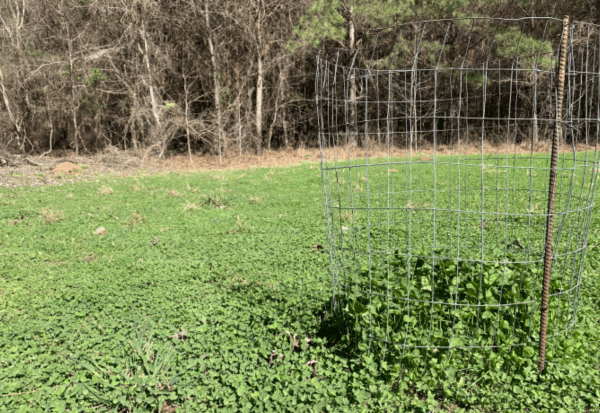
Figure 13. This exclusion cage in a white clover plot was taken in March. It shows heavy browsing by deer outside of the cage. This property may need better management of both the deer herd and the surrounding vegetation (note the shaded, closed canopy pines in the background). Without the cage, it would not be apparent whether the soil needed amendment with fertilizer or lime or if the plot was being heavily grazed.
An important, but often neglected, part of planting food plots is monitoring them and keeping records. Record the dates on which you till, plant, mow, and spray and the varieties and rates you plant. This can help you learn what worked and what did not, and keep you on track for next year. Exclusion cages can also be used to monitor forage growth and use by deer and other wildlife. The cages are easily built by wrapping chicken wire, hog wire, or cattle panels around a 3- by 4-foot square of stakes. These cages can help indicate whether a plot is poor due to overgrazing by deer or from other factors such as soil fertility, weather, hardpan, poor germination, or improper planting. They will also indicate if certain forages were more preferred than others. A cage filled with lush growth surrounded by a bare field is one indication that the local deer population has exceeded carrying capacity (figure 13).
Maintenance
Once you have gained experience planting plots, you may find that to be the easy part. Difficulty may come in knowing how to maintain plots and identify and control various issues and pests that reduce production. This generally requires understanding the life cycle of the varieties planted, how to amend soils under standing crops, and how to identify and control weeds through mechanical and/or chemical methods.
A major benefit of annual plots is that they are relatively trouble-free crops with minimal maintenance and limited weed issues. Annuals grow rapidly, often outcompete weeds, and rarely require mowing. Cereal grain and annual clover plots (such as the Easy Annual Hunting Plot and the annual deer and turkey mix plots) and are about as easy as it gets. Allow these plots to mature, and then mow and spray in August. Overseed grains from September to October. If planted previously, the heavy reseeding clovers will volunteer back.
Managing perennial plots can be quite involved. Most clover plots require at least one mowing to a height of 6 to 8 inches in the late summer because weeds often invade as the clover thins out. Timing is important because mowing before weeds seed out reduces future weed growth, and mowing before a long dry period can stress and drought-kill plots. Fertilization schedules are another variable. In general, clover plots annually require 300 pounds of 0-20-20 per acre. This is best split into two applications, one in mid-spring and another in early fall. Weather again is important—it is best to fertilize just before a light rain and to not fertilize when foliage is wet as it can burn the leaves and set them back.
Chemical weed control is perhaps the biggest obstacle and consideration for perennial plots. Accurately identifying weeds is important for selecting and applying herbicides. Also, identifying potential weed competition on a site before planting may help dictate crop selection and also guide preplant herbicide applications. For example, if a site has difficult-to-control broadleaves, it would be well-suited for grain and grass crops to allow for more broadleaf herbicide options. Also, not all weeds are necessarily a problem; after all, if the high-protein ragweed or Spanish needles invading your plot are being browsed by deer, are they really pests? Still, it is not uncommon for perennial plots to require spraying once or twice a year depending on the crop planted and the weeds present. Your county Extension office can assist in identifying weeds and outlining control methods.
An insect pest that can decimate many wildlife plantings is fall armyworms, which often show up in numbers from August to November. As sightings are confirmed in your region, it is a good idea to regularly scout your plots. For more information, see Extension publication ANR-1019, “Management of Fall Armyworm in Pastures and Hayfields.”
Late Planning and Plot Failure
Even the best-laid plans can be derailed for a multitude of reasons. Whether your young plot faced an extended dry period and died out, you were not able to plant in an ideal window, or armyworms decimated your crop, there are some options for last-minute plots. Because Alabama has such mild weather, the planting window for most cool-season crops is relatively broad, from September to November, with some areas of the state not seeing the first frost well into December. Sometimes simply replanting failed crops is a good option. Even though they may not see the full production of earlier- planted crops, they will still benefit the wildlife and the hunter. Also, the annual grains recommended in the Easy Annual Plot are inexpensive, readily available, and a good option for managers who find themselves in a pinch to provide green browse. Oats and wheat establish and green up so quickly that they can save a failed plot or the late planter.
Summary
CSFPs can be an important source of nutrition for wildlife and success for the hunter. The more planning and effort that goes into planting and maintaining plots will result in more production, use by wildlife, and sightings by hunters. However, CFPs are just one tool in a sound management plan for deer and other wildlife. For example, wildlife managers should also consider warm-season plantings, reducing forest canopy cover, managing for early successional vegetation, controlling invasive and non-native plants, and setting back plant succession using disking and prescribed fire. In addition, focused deer-harvest strategies will help balance herd to habitat and enable land managers to maximize the potential of their property and the nutritional impact of their supplemental plantings.
Additional Resources
- Harper, Craig A. Wildlife Food Plots and Early Successional Plants. NOSCO Publishing, Maryville, TN. 2019
- Extension publication ANR-0485, “Plantings for Wildlife”
- Extension publication FOR-2080, “Soil Testing, Liming, and Fertilizing Wildlife Food Plots”
 Norm Haley, Regional Extension Agent, and Spenser Bradley, former Regional Extension Agent, Forestry, Wildlife, and Natural Resources, both with Auburn University
Norm Haley, Regional Extension Agent, and Spenser Bradley, former Regional Extension Agent, Forestry, Wildlife, and Natural Resources, both with Auburn University
Revised November 2021, Cool-Season Food Plots for Deer: Planning, Planting & Maintenance, ANR-0592

